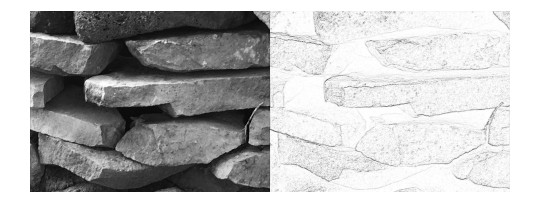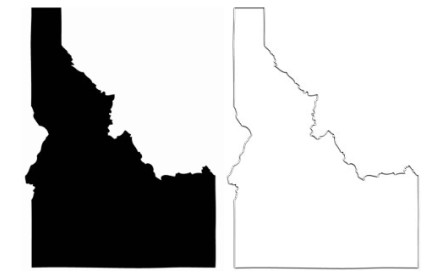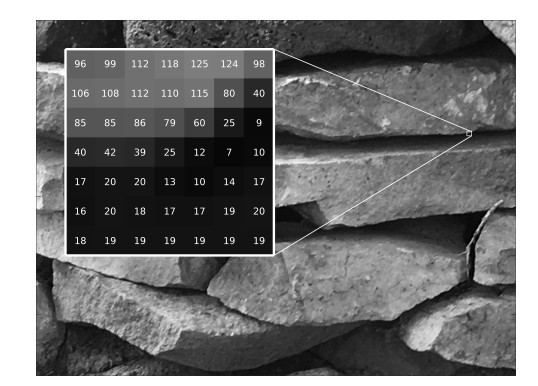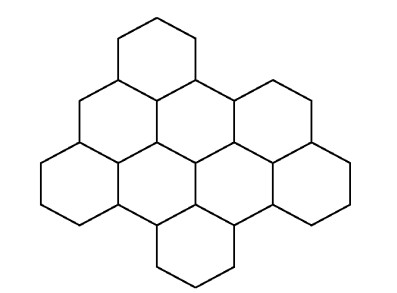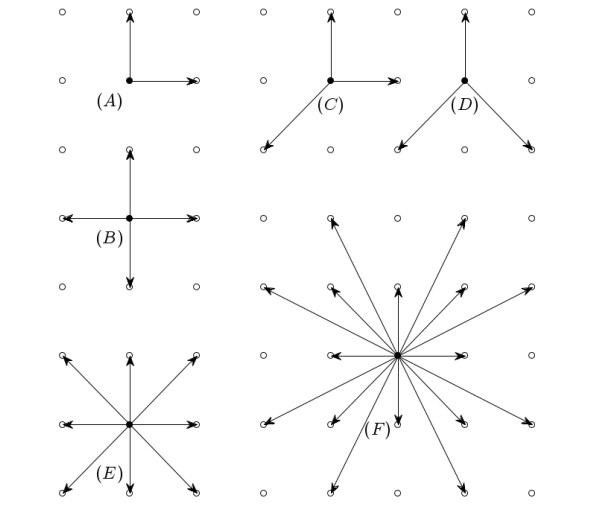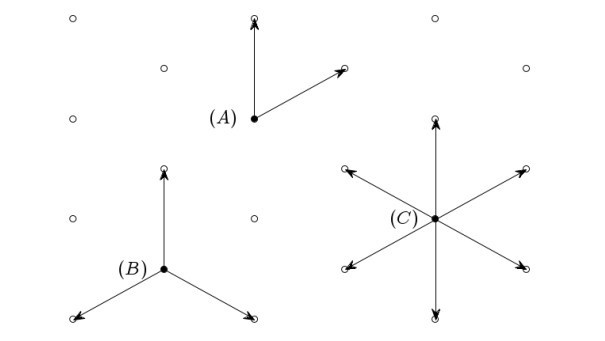The discrete anisotropic variation, sometimes referred to as the anisotropic gradient, and its integral are important in a variety of image processing applications and set boundary measure computations. We provide a method for computing the weight factors for general anisotropic variation approximations of functions on R2. The method is developed in the framework of regular arrays, but applicability extends to arbitrary finite discrete sampling strategies. The mathematical model and computations use concepts from vector calculus and introductory linear algebra so the discussion is accessible for upper-division undergraduate students.
1.
Brief highlights
In the last recent decades, interests have been directed towards PDE systems. Theoretical and numerical developments as well as practical studies have shown that these systems are better descriptors of several physical and natural phenomena than modelling with a single equation. Among these models nonlinear Schrödinger's systems of equations have taken a crucial role. Such types are applied in several fields such as optics, plasma, fluid mechanics, solitons' physics, chaos, fractals, ... etc.
However, we have noticed that most of the nonlinear Schrödinger system models developed revolve around cubic nonlinearities for both single and mixed nonlinearities composed of two or more terms. Few works have dealt with mixed terms with non-cubic parts. This may be due to the fact that in the cubic nonlinear Schrodinger equation the general form of the solution is the well known soliton type
where a, c, θ, φ and ϕ are some appropriate constants. It consists in fact of a soliton-type disturbance which travels with the speed c.
In our work we consider a mixed nonlinear term composed of two parts, a super-linear part and a cubic part. It may be understood as a perturbation of the cubic system. We propose to develop a classification of solutions, their behaviour, existence and uniqueness. We also noticed during this study that some chaotic behaviour can take place. Consequently, we have considered some types of dynamical systems from the Schrödinger system and we have carried out some numerical simulations of the chaotic behaviour of these systems. The chaotic behaviour in our knowledge is not yet investigated. This may be due to the perturbation of the cubic system.
2.
Introduction
Schrödinger equation since its discovery constitutes a challenging concept in physics as it models many phenomena in optics, plasma, fluid mechanics, etc. Enormous studies have investigated such an equation and the exact determination of solutions remains a complex task in the nonlinear case. In such a case even if we know some solutions, the linear combination may not be one also. Many types of solutions have been discovered in the nonlinear case such as solitons.
Recently, studies have been focused on the extension of such single equation to the case of a system of coupled equations of Schrödinger type and proved that such systems may describe better many phenomena in different fields such as simultaneous solitons, interaction of solitons, etc.
The present paper is subscribed in this last case and focuses on a special type of nonlinear coupled Schrödinger equations in one dimension space. We study a couple of NLS equations characterized by mixed nonlinearities involving convex and concave parts such as cubic, super-linear and sub-cubic power laws. Classification of the solutions as well as existence and uniqueness of the steady state solutions have been investigated. Numerical simulations illustrating the effects of the problem parameters on the solution are provided. We stress here on the fact that, in our knowledge, no previous study has investigated the present mixed case, but instead the majority of studies dealing with mixed nonlinearities have been conducted for the cubic-cubic special case.
The paper is devoted to the study of some nonlinear systems of PDEs of the form
where u=u(x,t), v=v(x,t) on R×(t0,+∞), t0∈R with suitable initial and boundary conditions. The operators L1 and L2 are linear Schrödinger-type operators of the form
leading to a nonlinear Schrödinger system. uxx is the second order partial derivative relatively to x, ut is the first order partial derivative in time, σi, i=1,2 are constant real positive parameters. f1 and f2 are nonlinear continuous functions of two variables.
Remark that for σ1=σ2=1, u=v=φ and f1=f2=f, we come back to the original Schrödinger equation
On the other hand, this last equation itself may lead to a system of PDEs of real valued functions satisfying a Heat system. Indeed, assume that u=v and let φ=u+iv=(1+i)u, we get a system of coupled Heat ones
where f1 and f2 are issued from the real and imaginary parts of f(φ).
Return again to the system (1) in the simple case σi=1 and denote φ=u+iv and f(φ)=f1(u,v)+if2(u,v), we come back to the classical NLS equation where u and v may be seen as real and imaginary parts of the solution φ of an equation of the form (2).
As related to many physical/natural phenomena such as plasma, optics, condensed matter physics, etc, nonlinear Schrödinger systems have attracted the interest of researchers in different fields such as pure and applied mathematics, pure and applied physics, quantum mechanics, mathematical physics, and continue to attract researchers nowadays with the discovery of nano-physics, fractal domains, planets understanding, etc. For instance, in hydrodynamics, the NLS system may be a good model to describe the propagation of packets of waves according to some directions where a phenomenon of overlapping group velocity projection may occur [16]. In optics also, the propagation of short pulses has been investigated via a system of NLS equations [25]. See also [33].
The most known solutions in the case of NLS equation are the so-called solitons. These are special wave functions characterized by a self-reinforcing wave packet and maintaining their shape along their propagation direction while their velocity is maintained constant. However, a rigorous and complete definition is no longer determined. Therefore, researches are always growing up to approach such waves. For example, it is well known in particle physics that solitons may interact to yield other forms of solitons as well as other physical particles. In [14] interactions of multi-soliton solutions have been studied with an asymptotic expansion. In [19] soliton type solutions are discovered for a couple of NLS equations in the framework of intensity redistribution leading to particles' collision. In [25] solitons solutions have been investigated in the case of propagation of short pulses in birefringent single-mode fibers governed by an NLS model. More about soliton solutions for single as well as coupled nonlinear Schrödinger equations may be found in [27,32,36,37].
In single NLS equation, studies have been well developed from both theoretical and numerical aspects. Recently, a mixed model has been developed in [4,5,6,7,8,9,10,15,20,21,24,26,34,35] with a general form
which coincides for u=v with the two variable extending interesting model
In the literature, few works are done on the general model (5). The major studies have focused on the mixed cubic-cubic (p=q=3)
For example, in [36], (2+1)-dimensional coupled NLS equations have been studied based on symbolic computation and Hirota method via the cubic-cubic nonlinear system
where α and σ are real parameters. The same system has been also studied by many authors such as [1,14,18,19,27,32]. In [37], the following more general system has been investigated for the asymptotic time behavior of the solutions,
See also [17]. In [13] the following p-Laplacian stationary system has been discussed for necessary and sufficient conditions for the existence of the solutions
where Δpu=div(|∇u|p−2∇u) is the p-Laplacian (1<p<N). In [11], solutions of the type
where u is a real function known as standing wave or steady state and w∈R has been investigated leading to the time-independent problem
See also [33]. Already with the familiar cubic-cubic case, numerical solutions have been developed in [38] for the one-dimensional system
on R, where u and v stand for the wave amplitude considered in two polarizations. The parameter β is related to phase modulation. u0 and v0 are fixed functions assumed to be sufficiently regular.
Coupled NLS system has been analyzed for symmetries and exact solutions in [23]. The problem studied is related to atmospheric gravity waves governed by the following general coupled NLS system.
It is noticed that such a problem may be transformed to the well known Boussinesq equation.
In [2] novel effective approach for systems of coupled NLS equations has been developed for the model problem
where f and g are smooth nonlinear real-valued functions depending on (|u|2,|v|2) and σ1, σ2 are real parameters. In [29] the following nonlinear cubic-quintic and coupling quintic system of NLS equations has been examined,
where u and v describe the complex envelopes of an electric field in a co-moving frame. α and γ are potentials. β and δ are amplifications. The functions fj and gj, j=1,2,3,4 describe the cubic, quintic and coupling quintic nonlinearities coefficients, respectively. m1 and m2 stand for the dispersion parameters.
In [22] existence of ground state solutions has been studied for the NLS system
x∈R, t>0, j=1,2.
In [30] a multi-nonlinearities coupled focusing NLS system has been studied for existence of ground state solutions and global existence and finite-time blow-up solutions. The authors considered precisely the coupled system
where uj:RN×R→C, j=1,2,…,m and the ajk's are positive real numbers with ajk=akj.
In the present work, we focus on the nonlinear mixed super-linear cubic defocusing model
with λ>0 and 1<p≠3. We consider the evolutive nonlinear Schrödinger system on R×(0,+∞),
Focuses will be on the steady state solutions according to their initial values. We propose precisely to develop a classification of the steady state solutions of problem (18) provided with the existence and uniqueness problems. We will consider specifically the case where the two waves u and v have the same frequency or the same pulsation ω. In this case, the steady state solution of problem (18) is any solution of the form
ω>0. Substituting W in problem (18), we immediately obtain a solution (u,v) of the system
We will see that classifying the solutions of problem (19) depends strongly on the positive/negative/null zones of the nonlinear function model
which in turns varies according to the parameters p, λ and ω. Denote
and
It is noticeable that such curves are more and more smooth whenever the parameter p increases. To illustrate this fact, we provided in Appendix 8.2 a brief overview for some cases of Γ1, Γ2 and Λ. See Figures 1 and 2.
Note here that Λ does not depend in fact on ω, and that the problem is symmetric in (u,v). However, if the two waves have different pulsations ω1 and ω2 we get a non-symmetric problem and new difficulties appear.
The paper is organized as follows. The next section is concerned with the development of our main results on the classification, existence and uniqueness of a coupled mixed cubic, superlinear sub-cubic Schrödinger system. Numerical simulations are also developed to illustrate graphically the theoretical findings. Section 3 is concerned to the development of the special cases regarding the initial value. Section 4 is devoted to some numerical simulations where a possible chaotic behavior of some dynamical systems issued from the original system is described. Such simulations make more deeper studies to be necessary for future directions to study associated chaotic dynamical systems. Concluding and future directions are next raised in section 5. Section 6 is devoted to some discussions of some special cases issued from the present study such as the case w=0 which corresponds also to the asymptotic problem where t goes to infinity. We also discussed in a second part the possible extensions of our results on the half-space and on the finite interval. Section 7 is the general conclusion of our work in which we raised possible extensions for other forms of coupled systems similar to the one studied here and the p[possibility to benefit from the calculus applied here. An appendix is developed in section 8 to illustrate the effects of the parameters of the problem on the classification of the solutions. We notice that the problem may be completely changing according to these parameters regarding the behavior of the solutions, existence of positive solutions, sign-changing. In some cases such as p<0 we may lose the Lipschitz characteristic of the problem and thus any study will necessitate different and more advanced techniques. For example, for some values of p and ω the region Λ∩[−1,1] is not contained in Ω2∪Ω4∪Ω8∪Ω11 as in our case. The second appendix concerns indeed the validity of Lipschitz theory in our case to guarantee the existence and uniqueness of the solutions.
3.
Main results
As it is noticed in the introduction, the behavior of the solutions depends strongly on the parameters of the problem, especially those affecting the sign of the function gω. It holds in fact that some of these parameters may be relaxed to
which simplifies the computations needed later. Indeed, denote
The functions ˜u and ˜v satisfy immediately the system
Moreover, consider the scaling modifications
where K1, K2, α and β are constants to be fixed. The functions ¯u and ¯v satisfy the system
The constants K1, K2, α and β satisfy
which in turns yields that
and
where
and
Given these facts, we will consider in the rest of the paper the problem (20) with the initial conditions
where a,b∈R. Denote also ωs=ω1s−1, for s∈R, s≠1. Figure 1 illustrates the partition of the plane R2 according to the curves Γ1 and Γ2. Figure 2 illustrates the partition of the plane R2 according to all the curves Γ1, Γ2 and Λ.
We now start developing our main results. For this aim, we assume in the rest of the paper that
It is straightforward that ωp>ω3. Moreover, the closed curves Γ1 and Γ2 intersect at four points B, D, F and H as it is shown in Figure 1. Notice also that the curves Γ1 and Γ2 split the plane (u,v) into twelve regions, Ωi, i=1,2,...,12 and an external region Ωext=⋃1≤i≤4Ωext,i. Such regions are in the heart of the classification of the solutions of problem (20)-(22). Notice also from the symmetry of the function gω that the points B and F satisfy the Cartesian equation u=v and the points D and H satisfy u=−v. Furthermore the polygon BDFH is a square. We may notice that the coordinates of the main points are A(0,ωp), I(0,ω3), B(uB,uB) where uB is the unique positive root of up−1+u2−ω=0. The points C, D, E, F, G, H, J, K and L may be deduced from A, B and I by symmetries.
The symmetry also shows easily that whenever (u,v) is a pair of solutions of the system (20), the pairs (−u,v), (u,−v) and (−u,−v) are also solutions. Consequently, in the rest of the paper we will focus only on the case where u(0)=a≥0 and v(0)=b≥0. The remaining cases may be deduced by symmetry. As the function f(u,v) is locally Lipschitz continuous, the existence and uniqueness of the solution are guaranteed by means of the famous Cauchy-Lipschitz theory. This will be proved in the Appendix later.
Theorem 3.1. Whenever the initial data (u(0),v(0))=(a,b)∈Ω1, the problem (20)-(22) has a unique (u,v) satisfying
i. u and v are oscillating,
ii. u is infinitely sign-changing and v is positive,
iii. (u,v) lies in Ω1∪Ω12∪Ωext,1∪Ωext,4.
Proof. Writing problem (20) at x=0 yields that
Hence, there exists δ>0 small enough such that
Consequently, u′ is nonincreasing on (0,δ) and v′ is nondecreasing on (0,δ). Next, as u′(0)=v′(0)=0, it therefore follows that u is nonincreasing on (0,δ) and that v is nondecreasing on the same small interval. We claim that u and v do not remain with the same monotony on the (0,∞) as at the origin. Indeed, assume for example that v remains nondecreasing on (0,∞). Then, it has a limit lv as x goes to infinity. Because of the energy functional E associated to problem (20) and defined by
and which is constant as a function of x, the limit lv is finite and positive. Consequently, u2 has also a limit Lu at infinity such that lp−1v+Lu−ω=0. Moreover, |u| goes to lu=√Lu. Henceforth,
Assume now that lu=0. In this case, the solution (u,v) lies in the region Ω1 with its limit being equals to the point A and such that u is nonincreasing and v is nondecreasing on the whole interval (0,∞). We get
On the other hand
So, consider for b fixed the function
We immediately get
as [0,a]×{b}⊂¯Ω1. Consequently,
Now consider the function
On the interval (b,ωp) it is a nondecreasing function. As a result,
We get a contradiction with the fact that E(u,v)(x) is constant. As a result, lu≠0. We conclude that
This yields that (lu,lv)∈{B,D,F,H} which is contradictory with the eventual monotony assumed for (u,v). We thus conclude that u and v do not remain with the same monotony as in the origin on the whole domain (0,∞). Let r1 and r2 be the first critical points of u and v respectively. Without loss of the generality we may suppose that r1≤r2. Denote next Mi=(u,v)(ri), i=1,2. We claim that M(r1)∈Ω12∪Ωext,4. Indeed, assume by the contrary that the turning point M1∉Ω12∪Ωext,4. Relatively to the position of the initial point M0=(u,v)(0)=(a,b) there are many cases for M1.
Case 1. M1∈¯Ω1. Multiplying the first equation in (20) by v and integrating on (0,r1) we get
which is contradictory.
Case 2. b≤ω3 and M1∈Ω2: In this situation we notice firstly that v(r1)≥yB. Let t0>0 be the first point in which the curve (u,v) crosses the curve (B,I). We immediately obtain
This is a contradiction as the left-hand and the right-hand quantities have different signs.
Remark 1. ∙ One may prove that for (a,b)∈Ω1 there exists ˜b>0 depending on a,b,p,ω such that the solution (u,v)∈(xH,xB)×(yB,ωp+˜b). A good question is to express ˜b by means of ω, p, a and b.
∙ For r1 and r2 defined above, is it true that (r1≤r2⟺a≤b)?
Figures 3, 4, 5, 6 and 7 illustrate some cases of the theoretical result proved in Theorem 3.1. In all these figures we fixed the parameters p=1.5 and ω=2. In Figure 3 we fixed the initial values (a,b)=(0.25,2.75). It yields that gω(a,b)=13.3317 and gω(b,a)=−0.4587 which confirms that (a,b)∈Ω1. In Figure 4 the initial values are fixed to (a,b)=(1,ω3−0.1) which gives gω(a,b)=0.6938 and gω(b,a)=−0.2830 which confirms here also that (a,b)∈Ω1. We notice clearly from these figures the compatibility with the result in Theorem 3.1. Moreover we provided in Figure 5 a sketching graph of both u and v starting inside of Ω1. The oscillating behavior of both u and v is clearly illustrated. Furthermore, to confirm again the oscillating behavior we provided in Figures 6 and 7 the phase plane portraits of u and v respectively. The figures show clearly the oscillating behavior.
The next result deals with the behavior of the solution when starting from an initial data (a,b)∈Ω2. We will see that the result depends technically on the position of the initial value in the four sub-regions Ω12, Ω22, Ω32, Ω42 shown in Figure 8. In fact we have
and
and where Gω(a,b)=gω(a,b)−gω(a,b). The region Ω12 will be the union
where ΓP1P2 is the curve joining the points P1 and P2 including them, ΓP2P3 is the curve joining the points P2 and P3 including them. [O,P2] is the closed segment joining the point O to P2 and finally [P2,B] is the closed segment joining the point P2 to B. In the sequel we will also use the following sets.
● ∘ΓP1P2 to designate the curve ΓP1P2 without the extremities P1 and P2.
● ∘ΓP2P3 is the curve ΓP2P3 without the extremities P2 and P3.
● ]O,P2[ is the open segment joining the point O to P2.
● ]P2,B[ is the open segment joining the point P2 to B.
Theorem 3.2. Whenever the initial data (u(0),v(0))=(a,b)∈Ω2, the problem (20)-(22) has a unique solution (u,v) where u and v are oscillating and may be both infinitely sign-changing.
Proof. We will develop the proof for the case (u(0),v(0))=(a,b)∈Ω12. The remaining cases may be checked by similar techniques with necessary modifications and by using the invariance of the domain Ω2 and problem (20) relatively to the axial symmetry u=v.
Whenever (u(0),v(0))=(a,b)∈Ω12 we may check by similar techniques as in the proof of Theorem 3.1 that
∙ u and v are nondecreasing on (0,δ) for some δ>0 small enough.
∙ u and v are oscillating on the whole interval (0,∞).
So, let as previously r1 and r2 be the first positive critical points of u and v, respectively and assume without loss of the generality that r1≤r2. We claim that M1=(u(r1),v(r1))∈Ω1∪Ωext,1. Indeed, assume that it is not true.
Case 1. Assume that M0∈¯Ω12. By multiplying the first equation in problem (20) by v and integrating on (0,r1) we obtain
which is contradictory.
Case 2. M1∈Ω42. Let M1=(u(x1),v(x1)),x1<r1 be the point where the curve (u,v) intersects [P2,B]. On [x1,r1] we get
which is impossible as the left and the right terms have opposite signs.
Case 3. M1∈Ω3. Let x2 be such that (u(x2),v(x2)) is the intersection point of the curve (u,v) with the curved line (B,J). Integrating the first equation in problem (20) multiplied by v on the interval (x2,r1) we get a contradiction as in case 1.
As a consequence of these cases we conclude that the point M1∈Ω1 and thus the solution (u,v) crosses at the curved line (I,B). Now, Theorem 3.1 yields the behavior of the solution.
Now similarly to the previous case we provide in Figures 9, 10 and 11 some graphical illustrations of the theoretical result proved in Theorem 3.2. We fixed here also for all these graphs p=1.5 and ω=2 as previously to be adequate with the previous case. The Figures show clearly the oscillating behavior of the solutions and show further the compatibility with the result in Theorem 3.2.
Theorem 3.3. Whenever the initial data (u(0),v(0))=(a,b)∈Ωext,1, the problem (20)-(22) has a unique solution (u,v) where
i. u and v are oscillating and may be both infinitely sign-changing.
ii. The first turning point of (u,v) belongs to Ωext,3∪Ωext,4.
Proof. It is easy to see that u and v are nonincreasing at the origin. Assume that they remain with the same monotony on the whole domain (0,∞). They will have therefore finite limits lu and lv respectively. We claim that lulv≠0. Indeed, assume in the contrary that lulv=0.
Case 1. lu=lv=0. In this case, the pair of solution (u,v) behaves at infinity like the solution of the problem
for which the energy E(u,v) satisfies at infinity
where ω0=√ω, which is contradictory.
Case 2. lu=0, lv≠0. In this case, u behaves at infinity like the solution of the problem
which is oscillatory. We get a contradiction.
Case 3. lu≠0, lv=0 is similar to the previous one. We thus conclude from all these cases that (u,v) behaves at infinity like the solution of the problem
So, they are both oscillatory, which is also contradictory. We conclude that u and v cannot remain with the same monotony on the whole interval (0,∞). Furthermore, they cannot have finite limits simultaneously. It remains the possibility that u is nonincreasiing with limit 0 and v is oscillating infinitely. In this case, u∼Ce−ω0x at infinity which in turns yields from the first equation in problem (20) that v2 goes to 0 at infinity, which is contradictory. So as Assertion i is proved. Assertion ii may be proved by similar techniques as in the previous theorems. In Figures 13 and 14 some numerical simulations are presented to illustrate the result of Theorem 3.3.
Besides, Figures 15 and 16 illustrate clearly the oscillating behaviour of the solution (u,v) whenever the initial values (a,b)∈Ωext,1.
4.
Study of the special cases
In this section we will consider the problem (20)-(22) when the initial value (a,b) lies on the frontiers of the region Ωi. An obvious case is when (u,v)(0)=(a,b)∈{O,A,B,C,D,E,F,G,H,I,J,K,L}. In this case the solution is always constant equals to its initial value (a,b) due to the Lipschitz theory. As a consequence we will consider in the rest of this section the non trivial cases. Here also because of the symmetries of the problem we will consider only the case 0≤a≤b.
4.1. Case 1: (a,b)∈)A,B(.
As usual u starts by decreasing on a small interval (0,δ), for some δ>0 small enough. Now at x=0 we have
Even though we claim that v can not remain constant on any interval (0,δ), δ>0. Indeed, if this occurs on some interval (0,δ), we get immediately
So, |u| is also constant (≡a) on (0,δ). Therefore, we get
This means that
which contradicts the fact that |u| is constant, except if K1=0. However, in this case we again get a=0, which is contradictory. So as the claim. Consequently, two situations may occur. (i) the pair solution (u,v) remains on the edge )A,B( and being non constant. (ii) the pair solution (u,v) bifurcates toward Ω1. Whenever the situation (i) occurs we immediately conclude that v is constant, which is a contradictory with the previous claim. Consequently, the situation (ii) occurs only. Next, as in the previous cases, u cannot remain nonincreasing on (0,∞). So, let r0>0 be the first positive critical point of u. That is, u′(r0)=0 and u′(x)<0 for all x such that 0<x<r0. By applying similar techniques as previously we deduce that the turning point M0=(u(r0),v(r0))∈Ω12∪Ωext,4 and thus the solution (u,v) joins the class described in Theorem 3.1 and the symmetric behavior of the one described in Theorem 3.3 relatively to the y-axis.
Figures 17, 18, 19 and 20 illustrate graphically the theoretical results above. Notice here that the initial values a and b are related by gω(b,a)=0 which is equivalent to a=√ω−|b|p−1. We fixed here p=1.5 and ω=2.
4.2. Case 2: (a,b)∈{0}×(0,∞)∖{A,I}.
In this section we assume that the initial value (u,v)(0)=(0,b)∈]0,ωp[∖{ω3}. Using the well known Lipschitz theory we immediately observe that u≡0 and thus the problem (20)-(22) becomes
where w3<b<wp. Denote
Denote also
Consider firstly the case where b∈(0,ωp)∖{ω3}. In this case, we have vp<wp<˜vp. Notice that the function g is even and is nondecreasing on (0,∞). Moreover g(ωp)=0 and g is positive on (ωp,∞). Now, at the origin x=0, v starts by increasing. Whenever it continues with the same monotony on (0,∞) it has the unique finite limit lv=ωp>b. However in this case, v behaves at infinity as the solution z of
which is oscillatory which in turns contradicts the its monotony. As a consequence v is oscillatory on (0,∞) infinitely. Let ζ0=<ζ1<ζ2<⋯<ζ2k<ζ2k+1…, k∈N be the sequence of successive critical points of v such that ζ2k, k∈N are the maximums and ζ2k+1, k∈N are the minimums. We claim that
Indeed, for k=0 for example, we have
Whenever v(ζ1)<wp we get from (24)
which is contradictory. Similarly for the rest (By recurrence on k). As a result we proved the following result.
Theorem 4.1. For all b∈]−ωp,ωp[∖{0} the problem (24) has a unique solution which is oscillatory around ±ωp infinitely. Furthermore, there exists (ξk)k and (ζk)k satisfying v(ξk)=−ωp for all k) or (v(ξk)=ωp for all k), v′(ζk)=0 and the alternance
Consider now the case where b>ωp. As in the previous cases, the solution v is not monotone on its whole domain (0,∞). Indeed, v is nonincreasing at the origin. If it continues with the same monotony it has two possible limits at infinity, lv=0 or lv=±ωp. Consider the energy functional associated
which is obviously constant as a function of x. So, whenever lv=0 and b≠˜vp we obtain
which is contradictory. Now, whenever lv=0 and b=˜vp we obtain E(v)(x)=0 for all x. Consequently, v′(x)=−√−2F(v)(x) for all x. Integrating on (0,∞) we get
which is impossible. Now, if the limit is ±ωp the solution v behaves at infinity as the solution z of the problem
which is oscillating. So, we get a contradiction also. We thus conclude that v cannot be monotone on (0,∞). Let next x0 be the first critical point of v. We claim that 0<v(x0)<ωp. If not, we have one of the following cases.
i. v(x0)≥ωp.
ii. v(x0)=0.
iii. −˜vp≤v(x0)<0.
iv. v(x0)<−˜vp.
In the case (i.) we obtain
which is contradictory.
In the case (ii.) we obtain for η/0 small enough
which leads to a contradiction.
For the case (iii.) let ζ0>0 be the zero of v on (0,x0). We obtain in one hand E(v)(ζ0)=12v′(ζ0)2>0. On the other hand, E(v)(x0)=F(v(x0))<0. This is contradictory as the energy E(v) is constant.
For the case (iv.) let ζ1∈(0,x0) be such that v(ζ1)=−˜vp. It holds immediately that F(v(x))>0 on (ζ1,x0). Now observing that v′(x)2=−2F(v(x)) on (ζ1,x0) we get here also a contradiction.
From all these cases we conclude that 0<v(x0)<ωp. Applying next the same techniques we obtain the following result.
Theorem 4.2. For all b∈]ωp,∞[ the problem (24) has a unique solution which is oscillatory around ωp infinitely. Furthermore, there exists (ξk)k and (ζk)k satisfying v(ξk)=ωp for all k, v′(ζk)=0 and the alternance
4.3. Case 3: (a,b)∈)I,B(.
This section is resembles somehow to the one where the initial value (a,b) belongs to the curved arc )A,B( as the problem is symmetric in (u,v). In fact we observe that Γ1 and Γ2 are symmetric by means of the axial symmetry x=y. Moreover the curve Λ is invariant via the same symmetry. This permits to deduce the result in the present case easily.
Figures 21, 22 and 23 illustrate graphically the behavior of the solution for (a,b)∈)I,B(. Recall that in this case the initial values a and b are related by gω(a,b)=0 which is equivalent to b=√ω−|a|p−1. We fixed as usual p=1.5 and ω=2.
4.4. Case 4: a=b∈(0,∞).
In this section we propose to study the case where the functions u and v start from the same origin point u(0)=v(0). It is straightforward that u≡v on the whole domain (0,∞). Consequently we obtain the single problem
The situation here is similar to subsection 4.2. Indeed, denote
Denote also u_p,ω, up,ω and ¯up,ω the positive unique zeros of g, f′ and F respectively. In other words, u_p,ω is the unique positive real number such that
Similarly, up,ω is the unique positive real number satisfying
Finally, ¯up,ω is the unique positive real number for which
We may check easily that
Consequently, by applying similar arguments as in subsection 4.2 we get the following results.
Theorem 4.3. For all a∈]−up,ω,up,ω[∖{0} the problem (27) has a unique solution which is oscillatory around ±up,ω infinitely. Furthermore, there exists (ξk)k and (ζk)k satisfying v(ξk)=−up,ω for all k) or (v(ξk)=up,ω for all k), v′(ζk)=0 and the alternance
Theorem 4.4. For all a∈]up,ω,∞[ the problem (27) has a unique solution which is oscillatory around up,ω infinitely. Furthermore, there exists (ξk)k and (ζk)k satisfying v(ξk)=up,ω for all k, v′(ζk)=0 and the alternance
5.
Some possible chaotic behavior
We provide in the present section some numerical simulations where an eventual chaotic behaviour of the solution is clearly recorded. Figure 24 concerns the dynamical system
Figure 25 is simulated for the dynamical system
For Figure 26 we considered the dynamical system
For Figure 27 we considered the dynamical system
6.
Further discussions
6.1. Steady state solution with w=0
In investigating NLS equation as well as system, steady state solutions constituted a large set of studies. These solutions may be obtained as waves propagating with some positive frequency as dealt in the previous sections. Another way to obtain a different class of steady state solutions is to let the time t approximate ∞ which is also equivalent to relax the frequency to w=0. In this case the problem (20)-(22) becomes
Notice here that the nonlinear function model is
which is a positive function. So, the case here resembles in some sense to the cases where the initial value (a,b)∈Ωext investigated in the previous sections. Indeed, the curves Γ1 and Γ2 are reduced to
and thus the whole plane R2 will be splitted into regions according to Λ as in Figure 28. The energy functional associated to (34) is written as
As in the previous sections, this energy is constant and positive and satisfies precisely
This guarantees that the solution (u,v) is bounded and oscillating infinitely without limit. Table 1 and Figures 29, 30, 31 and 32 illustrate the behavior of the solution (u,v) of problem (34) for some cases,
To illustrate more clearly this behavior, we provided in Figure 33 the phase plane portrait (u′,u) for p=1.5, w=0 and (a,b)=(0.25,0.5538)∈Λ corresponding to Figure 29. Figure 34 illustrates the phase plane portrait (v′,v) for p=1.5, w = 0 and (a,b) = (0.25,0.35)\in R_2 corresponding to Figure 30. Figure 35 illustrates the behaviors of u and v separately for p = 1.5 , w = 0 and (a,b) = (0.5,1)\in R_1 corresponding to Figure 31. We notice easily from all these figures the oscillating behavior of the solution (u,v) . Finally, Figure 36 represents the energy E(u,v)(x) for w = 0 at the top and w = 2 at the bottom. We notice easily that the energy is constant as a function of x , which is already confirmed theoretically.
6.2. Steady state solutions on the half-space and the interval
Remark that in our study for reasons of symmetry (parity properties of the nonlinear part) problems (18) and (19) or the simplified form (20) are invariant under the transformation u(x)\rightarrow u(-x) . This is also applicable for the last special case (34). Notice that all these problems are also autonomous (relatively to the space variable x ). All these reasons make it possible to extend the results on all the real line.
However, on a finite interval such that [0,1] this needs a deep study as we notice clearly that the constants \sigma_1 , \sigma_2 and \lambda could not be relaxed simultaneously as in the present case. This will allow to loss many symmetry characteristics of the problem, the subdivision of the plane \mathbb{R}^2 into regions according to \Gamma_1 , \Gamma_2 and \Lambda . This will induce careful modifications in the study. Nonetheless, we may adapt the techniques developed here to a finite interval such as (0,1) in a special case where the first zeros of u and v coincide, but for a slightly modified (by scaling laws) problem. Indeed, denote x_0 the first common zero for u and v and consider the scaling versions
The pair (\widetilde{u},\widetilde{v}) satisfies the re-scaled version of problem (19) on (0,1) as follows
This means that relaxing all the parameters simultaneously as in the case of the whole line such as the case investigated in our present work could not be applied. Many ideas have been investigated especially in the single case of NLS equation such as the so-called shooting parameter method and also the well-known Emden-Fowler transformation. These are motivating ideas to re-consider the extension of the present study on finite intervals.
The shooting parameter method consists in fixing the value of the solution at the last extremity of the interval (for example x = 1 when considering the interval (0,1] ) and studying its behavior at the origin. The Emden-Fowler approach consists in transforming the problem on (0,\infty) to the interval (0,1) and vice-versa, and next deducing the behavior of the solution of the original problem from the one of the transformed version. See for instance [3,12,6,7,9,28,31].
7.
Conclusion
In the present work, 1D problem of coupled NLS equations has been investigated for the classification of the steady state solutions in the presence of mixed nonlinearities, a first odd cubic term added with a second odd superlinear subcubic one. Classification of the solutions as well as existence and uniqueness of the steady state solutions have been investigated. Numerical simulations have been provided illustrating graphically the behavior of the solutions such as oscillating and phase plane portraits.
Inspired from the present work, some analogue studies may be of interest such as the radial problem in higher dimensional cases where for the example no conservative energy could occur.
We may also consider cases where assumption (23) does not hold. For example, for p<0 the Lipschitz characteristic of the problem is not satisfied which necessitates different and more advanced techniques for the study. For some values of p and \omega the region \Lambda\cap[-1,1] is not contained in \Omega_{2}\cup\Omega_{4}\cup\Omega_{8}\cup\Omega_{11} which induces more and more difficulties and different behaviors for the solutions.
Moreover, we may be interested in coupled problems such as
● The Heat operator
leading to a nonlinear Heat system.
● The mixed Schrödinger-Heat operator
leading to a nonlinear coupled system of Schrödinger-Heat type.
Finally, as discussed above, considering similar study on finite interval is also of great interest. A forthcoming study in the case of higher dimensional space \mathbb{R}^N , N\geq2 is at the mid of being achieved.
8.
Appendix
8.1. Appendix A
Recall that in the previous sections, we applied for many times the well-known Cauchy Lipschitz theorem on the existence and uniqueness of solutions. In this section and for convenience, we will show that the generator function used is already locally Lipschitz continuous.
Denote \varphi = u' and \psi = v' . The system (20)-(22) becomes
Denoting X = (u,v,\varphi,\psi)^T , where ^T stands for the transpose, we get
where F is the function defined by
Lemma 8.1. F is locally Lipschitz continuous on \mathbb{R}^4 .
Proof. Let \delta>0 be small enough and X^0 = (x_1^0,x_2^0,x_3^0,x_4^0)\in\mathbb{R}^4 be fixed. For all X,Y in the ball B(X^0,\delta) we have
We shall now evaluate the quantity (g(x_1,x_3)x_1-g(y_1,y_3)y_1)^2 . Similar techniques will lead to (g(x_3,x_1)x_3-g(y_3,y_1)y_3)^2 . We have
where C_1(p,X_0,\delta)>0 is a constant depending only on p , X_0 and \delta . C_2(X_0,\delta)>0 is a constant depending only on X_0 and \delta . C(p,X_0,\delta,\lambda)>0 is a constant depending only on p , X_0 , \delta and \lambda . Therefore,
Similarly,
with some constant \widetilde{C}(p,X_0,\delta,\lambda)>0 analogue to {C}(p,X_0,\delta,\lambda) . Combining all these inequalities, we obtain
8.2. Appendix B
In this part, we investigate the dependence of the different regions \Omega_i , i = 1,\dots,12 , \Omega_{ext,i} , i = 1,\dots,4 and the different curves \Gamma_1 , \Gamma_2 and \Lambda on the parameters p and \omega . So denote \Lambda^* = \Lambda\setminus\{(u,v)\in\mathbb{R}^2;\;|u|\not = |v|\} . Denote also \Omega_{int} = \bigcup\limits_{i = 1}^{12}\Omega_i and \mathcal{A}_p the interior area countered by the curve \Lambda^* .
Lemma 8.2. The area \mathcal{A}_p\subset[-1,1]^2 .
Indeed, denote for (u,v)\in\mathcal{A}_p
It is straightforward that r is maximum whenever (u,v) is on the frontier \Lambda_{p}^* , which may be then governed by the polar equation
Otherwise,
Straightforward calculus yield that whenever 0<p<3 , the radius r is extremum for \theta\in\{0,\pm\frac{\pi}{2},\pi\} , which gives the vertices (\pm1,0) , (0,\pm1) . In fact r(\theta) may be extended at \theta = \{\pm\frac{\pi}{4},\pm\frac{3\pi}{4}\} . However, these points yield immediately |u| = |v| , which is the trivial (unbounded) part of \Lambda .
As a result of Lemma 8.2, we immediately deduce that whenever 0<\omega\leq1 and 1<p<3 the inclusion \Omega_{int}\subset\mathcal{A}_p . However, for \omega\geq1 and 1<p<3 , the area \mathcal{A}_p is contained in the curved octagonal shape IBJDKFLH .
Acknowledgment
The authors would like to thank the editor and the handling editor of ERA as well as the anonymous referees for the time they have spent to evaluate our work. Their comments have been of great importance and have improved the present work well.
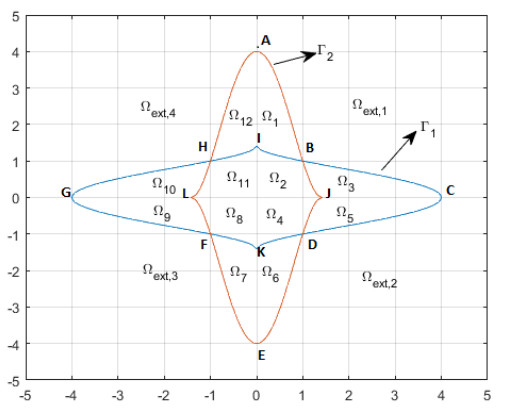









 DownLoad:
DownLoad:










































